|
Early Valentines of the Late-18th – Mid-19th Centuries
by Barbara Johnson, Ph.D.
For centuries, people have
found different ways to
express their feelings of love
and affection. Many of these
gifts and love tokens did not
stand the test of time. The
only testament we have today
of these past proofs of tender
feelings are valentines. This
special greeting card can
evoke the same emotional
response from us today as
the collectors of cards and
cherishers of custom. The
fascination with the valentine
is probably due to our core
basic human need to love
and be loved. The valentine
as an art form transforms
itself and is remarkable
because of the fragility of its
nature. The ethereal beauty
of the late-18th to mid-19th
Centuries valentine is the
subject of this article. While
growing scarcer with time,
early valentines are still
circulating for purchase as
well as being in the hands of
private collectors, museums
and historical societies.
|
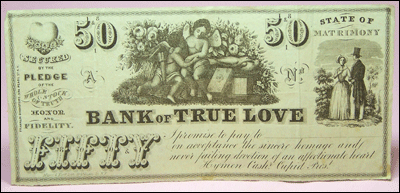
|
| Photo 2.
“Bank of True Love,” engraved note implying the state of
matrimony was on the mind of the sender, published by
Franklin
Bookstore, New York, ca. 1847.
|
The most remarkable fact
about early valentines is that
collectors can misidentify
what they own. Much has to
do with the lack of familiarity
over the different styles
of printing and lace paper.
Collectors should thoroughly
study the 19th Century lace
paper makers, embossers
and valentine publishers.
Chromolithography was
invented in 1798. Some
early-to-mid-19th Century
valentines had different sorts
of scraps and ornamentation
that made their features
distinctive and easily
recognizable. Recognizing
scrap differences through
the century can help date a valentine to the proper
decade. Early scraps looked
like small, flat-colored print
cut outs. Besides being flat,
additional types of early
scraps could be embossed
and were of a single color.
They relied on the embossing
for dimension to distinguish
the design.
As decades progressed,
chromolithographed scraps
became increasingly
popular. By the mid-tolate
19th Century, they are
recognizable by their rich
colors and wide range of
tones due to the perfection of
chromolithograph printing.
The colorful scraps we have
come to be familiar with in
Victorian scrapbooks are of
the latter kind.
It was fashionable from
the 18th Century to the
early 19th Century to hand
craft your valentine using a
combination of techniques.
Some individuals produced
cut out valentines resembling
the paper-cut snowflake
ornaments we make during
the holidays. Senders might
cut initials and hearts into
the design. Some early artists
used pinpricks to create
pictorial valentines. Others
used painted flowers (Photo
1) with all the beauty of
an illuminated manuscript.
Some used creatively-folded
cards that showed artwork
carefully folded into a paper
purse to be opened and read
by the recipient. Important
themes included love knots,
gloves and flower cages
which feature central flowers
surrounded by a cage of
flower or greenery swags
encircling it (Photo 1).
The shy or socially-reserved could use clever
means of design to get their
messages across to their love
by using acrostics, rebuses
or cryptograms to hide
their messages of affection.
These valentines remind
us of the vastly different
social conventions and strict
propriety that defined the
way these individuals could
express affection.
Perhaps the most
recognizable of these period
valentines for collectors is
the “Poonah” or “Theorem”
valentine. These 1830s-
1840s hand-painted flowers
resemble our modern
stenciling techniques (Photo
1). Late 18th-to-early 19th
Century valentines in
retrospect encompassed many
distinctive and beautiful art
forms.
The collector of these
earliest valentines needs
to do thorough research to
recognize features that are
unmistakable. The subjects
of the early cards are classical
symbols of love. Cherubs and
angels might bedeck the card.
Naturalistic themes, such as
love birds or flowers, might grace the design. The most
important embellishments for
color were applied flowers
(Photo 3) and paper wafers
placed behind paper lace to
provide contrasting color
(Photo 5). This was the age
of more refined valentines.
Other varieties of design
themes included nautical
and classical features.
Early 19th Century war
and nautical activities were
common concerns for
Britain and America so it is
not surprising sailors and
ships figure into the early
designs of valentines. They
were identifiable images and
themes of concern for those
giving love tokens as well as
those receiving them.
Classical figures also help
identify cards of this period
(Photos 5 & 10). Engraved
valentines were popular.
Stationers concocted such
novelties as the 1840’s
“Bank of True Love” notes
to pledge love and fidelity
to the recipient while closely
resembling currency of the
times (Photo 2). Other early
engraved valentines depicted
couples in romantic scenes.
The greatest achievement
of this time in valentine
history is the development
and the use of paper lace and
paper embossing. Thanks to wonderful British makers,
these artistic developments
made British valentines true
masterpieces. American card makers took British artistry
one step further by creating
their own valentines using
British embossed paper and
paper lace. Both constructed
cards with a bevy of
embellishments added to the
paper lace. The beautiful
embossed paper lace and
cards featured figures (Photos
5, 6, 7 & 10), cupids (Photos
5 & 9), flowers (Photos 3, 6,
& 9), shells (Photo 4), cameostyle
embossing (photos 5
& 7), pastoral scenes and
churches (photo 6).
|
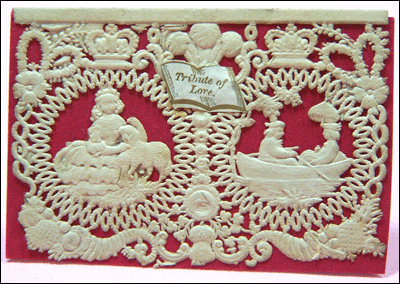
|
| Photo 7.
Very small cameo-embossed paper lace valentine
(2 x 2 3/4
inches), 18th C. clad king in a rowboat and queen with a
lamb, crowns overhead; dated Feb. 14, 1865.
|
Much appreciated by
the collector is the use of
sparkling gold or silver
“Dresdens,” or scraps of
gilded or silvered embossed
paper. Tiny metallic scraps,
now oxidized into a grayish
rainbow color, were affixed
to ornament the paper
lace, silken fabric or white
embossed paper base (photo
4). Some 1840s valentines
even had small metal mirrors
applied so the receiver could
see they were the sender’s
beloved.
The early valentine also
had applied artificial flowers
(Photos 8 & 10), mosses, die
cut flowers (Photo 3) and
leaves (Photos 8, 9 & 10)
made of embossed fabrics or
paper. Verses were usually
applied as scraps onto the
valentine front and/or inside.
Some very special
valentines of the 1860s were highly ornamented,
perfumed sachets. These
featured a stuffing under the
scrap or ornamental paper
which could be scented with
perfume for the enjoyment of
the recipient.
Besides using silk satin on
some sachets, card makers
utilized the beauty of silk
elsewhere as backings behind
the card’s embellishments or
affixed as special appliqués
with printed verses (photos
4, 8 & 9). Colored scraps,
Dresdens and painted verses
were applied. By the 1850s-
1860s, paper lace was white,
gilded, silvered or colored
(photos 3-10).
One of the most important
innovations of valentines
late in this time period is the
invention of the paper spring.
These accordion-shaped
hinges would act as lifting
devices under different lace
or embellished layers of the
valentine to give beautiful
dimension to the front design
elements. Flowers, cupids,
romance and roses remained
some of the prettiest
themes, now made even
more interesting in threedimensional
quality. The
paper springs would remain
popular through the latter
Victorian decades (photos 8,
9 & 10).
Collectors should seek out some of these fine
examples of early valentines
as a special addition to any
valentine collection. These
rare cards are now more
easily distinguishable once
collectors know important
details. Collectors should
look for the maker’s
name embossed or printed somewhere on the front, in
the paper lace, on the edge
or on the back. Early British
and American valentine
publishers and lace and
embossed papermakers very
popular to collect include:
Addenbrooke, Dobbs, De La
Rue, Elton, Fisher, Goodall,
Goode, Howland, Kershaw, King, McLoughlin, Magnus,
Mansell (photo 4), Meek,
Moody, Mossman, Mullord,
Nister, Prang, Rimmel,
Stevens, Strong, Tuck, Turner
& Fisher, Ward, Whitney,
Windsor (photo 9) and Wood
(photo 5). This list is not exhaustive but represents
those responsible for this
period’s most beautiful and
popular valentines.
Early valentines offer
collectors a chance to see the
delicacy and care taken in
their creation. These unique masterpieces are truly refined
tokens of love and affection.
A modest sense of taste
comes forth when compared
to later Victorian versions.
The early valentine is an
antique that truly epitomizes
a Golden Age of valentine
artistry. Opening up a
window into the secret or
open hearts of our ancestors,
they are artistic statements
of love expressed in past
times when open expression
might not be acceptable.
Whether sedate or ornate,
the early valentine offers a
breathtaking presentation
in fascinating variety for
collectors. We marvel at the
skilled craftsmanship of early
makers as they alone enabled
our ancestors to exchange the
most stunning of valentines.
_________________________
About the Author: Barbara Johnson,
Ph.D. is a sixteenth-century British
cultural historian. She specializes in
the material objects of Elizabethan and
Jacobean aristocrats and their lives in
their country homes. She is the author of
Antique and Vintage Fashions, 1745-1979
by Collector Books, August, 2009 and
Valentines, A Collector’s Guide 1700s-
1950s, by Collector Books, 2010. Books
are available at www.collectorbooks.com,
in bookstores and online.
|
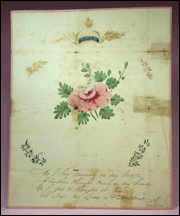
Photo 1.
Poonah, or
Theorem,
valentine with
a hand-painted
central flower
surrounded by
a flower cage
and topped
with “love,”
handwritten
verse; February,
1840.
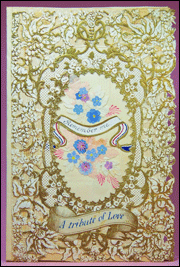
Photo 3.
Gilded embossed
lace paper
valentine with
applied flowers,
hidden verses
under silk leaves,
satin center; ca.
1858-early 1860s.
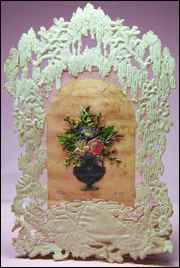
Photo 4.
Embossed valentine by Mansell
with silk center, painted interior
verse, applied Dresden and
embossed floral and urn scraps,
embossed paper depicts a coral
reef and shells, ca. late-1850s to
mid-1860s.
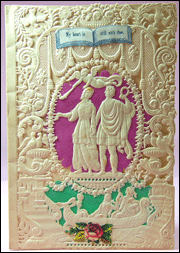
Photo 5.
Cameo-embossed paper lace
valentine, cupid, doves, classical
figures, applied verse, paper
wafers behind the embossing to
show detail; ca. late 1850s-early
1860s.
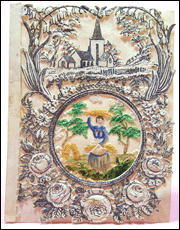
Photo 6.
Embossed silver and white
paper lace valentine, multicolored
tinting on embossing,
dual scene of church and
agricultural figure, ca. mid-
1860s to early 1870s.
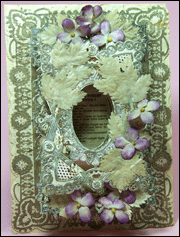
Photo 8.
Three-dimensional valentine of silver (oxidized) and
white embossed paper lace, paper spring hinges for
dimension, silk oval center with printed verse, applied
leaves and flowers; ca. mid-1860s to early 1870s.
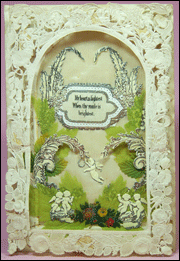
Photo 9.
Three-dimensional valentine of white, embossed paper
lace by Windsor, paper spring hinges for dimension, silk
back, applied fabric leaves, embossed and silvered scraps
of leaves and cupids, silk and paper lace appliqué with
printed verse, applied scraps of flowers; ca. mid-1860s to
early 1870s.
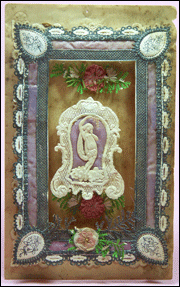
Photo 10.
Three-dimensional
chromolithographed
valentine of silver
(oxidized)-and-white
embossed paper lace,
paper spring hinges,
purple silk trim,
applied silk flowers,
colored and silvered
paper leaves, central
motif of classical figure
backed by purple
silk and embossed
miniature paper lace
frame; ca. late 1860s
to early 1870s.
|